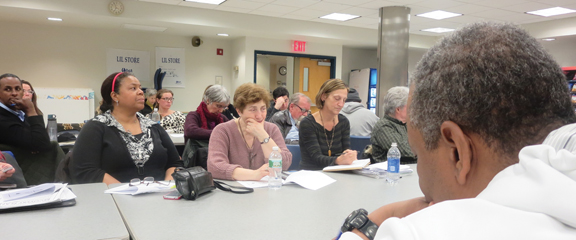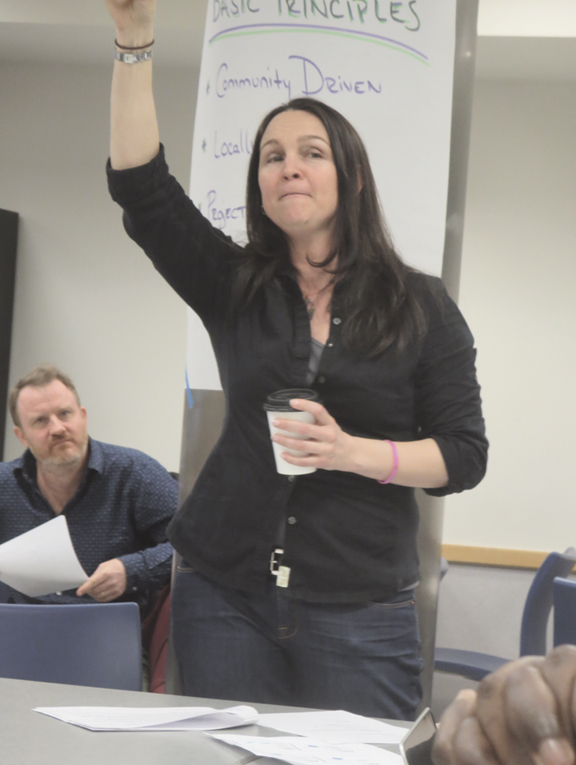The Red Hook Coalition held a long-awaited public meeting on March 18th, in the lunchroom of the South Brooklyn Community School on Conover Street. The meeting was advertised with flyers and on Facebook, inviting the Red Hook community to give input into a disaster recovery plan they are working on. As the flyer explained “The first 72 hours after a disaster of any kind, official rescue operations will not be on the ground. We need to be prepared with our own plan, unique to the resources and strengths of our community. Friends, Neighbors and Stakeholders… please join together to help forge this plan.”

Martha Bowers, founder of Red Hook’s Dance Theatre Etc. addressed the packed cafeteria first. She introduced Nahisha McCoy, who is serving as Coalition Assistant. She passed along a message from Reg Flowers, who was not in attendance, explaining that the project that is being worked on is modeled after something called the National Response Framework.This is a FEMA directive, and is explained in detail on their website http://www.fema.gov/national-response-framework. She stressed that this is a community project, written by the community, for the community. There is a committee meeting to work on the project, followed by a community meeting, such as the one we were at, seeking community input. There are two more public meetings scheduled – April 10 and May 7 – both will be at the South Brooklyn High School, 173 Conover Street, at 6 pm.
There was a political presence at this meeting, with Dan Wiley representing Nydia Velazquez and Karen Broughton speaking on behalf of Felix Ortiz. A sharply dressed Carlos Menchaca himself appeared with his staff, and spoke with his usual enthusiasm of the importance of the project.

Martha took some questions before introducing the group facilitator, Noel Kepler. Someone asked about the makeup of the Red Hook Coalition. She explained that the coaltion was a steering committee of Red Hook organizations, formed to access funding opportunities such as the Brooklyn Community Foundation. Those groups include the Red Hook Volunteers, Southwest Brooklyn Industrial Development Corporation, Added Value Farm, Red Hook Initiative, Dance Theater Etcetera, Falconworks and Good Shepherd Services.
Emergency Management Methodology Partners (EMMP) has been hired by the Red Hook Coalition to help create the disaster plan. EMMP is headed by Noel Kepler, who facilitated the meeting. She has been in Red Hook before with a project called “Tell Your Story.”
Tell Your Story was to be a move about people’s reactions to Sandy. Filming took place over several sessions at Kentler about a year ago. The finished movie would become a tool for future emergency management planning.
A Facebook page details the planning and execution of the project, including a teaser for the movie and YouTube news reports on the filming, including comments from Florence Neal, owner of the Kentler International Drawing Space.
One of the last postings on the page explained that the movie debut would be postponed. It was originally to be part of a benefit show, and the following explanation was offered:
“Unfortunately, one of our largest sponsors has decided to pull their support of the upcoming benefit citing personal reasons. By pulling out the sponsor took more than half the budget for this benefit with him. Originally scheduled for June 13, we will now need to postpone and find a new path forward for this event.”

A call to Kentler revealed that nobody there had ever seen the promised movie. Victoria Hagman of Realty Collective, whose blog posting about Tell Your Story is featured on the EMMP website, has also never seen the movie. The project fell apart, with only a shortened version that can be seen on YouTube. Kepler said in an email: “We turned over all of the footage and video to the individuals who participated in the project and the Coalition. The day of our video shoot in the Houses, everyone canceled. Something had changed and people decided they did not want to be part of the project, so the video turned out to be very different than what we had planned.”
Kepler is a very personable, bouncy woman – a perfect facilitator. Her offices are at 45 Duffield Street, and she told the crowd that she was delighted to be working in Red Hook, as she loves the community and spends time here for fun. She applauded Red Hook’s spirit of community and called the crowd ‘a sea of incredible faces.’
She explained that the community presentation, of which this was the first, followed a committee meeting at which a recovery plan was worked on. She explained that this was to be a living document that would be available in the event of a future disaster situation. It would include information that the community would need in the time period before other help could show up. It was pointed out that Red Hook did pretty well after Sandy, with emergency plans and communications set up as needed, and that a huge problem was lack of electricity. Asked whether a representative from Con Ed might not be a good addition to the committee, Kepler said that they did call the utility, but did not get a positive response.
It ended up that nothing specific was discussed at their first committee meeting, so nothing specific was mentioned in this community meeting. Instead, they discussed who they were and why they were. This was all summarized in a slide presentation that was handed out and recited by Kepler. It began with a cover page called “Long-Term Community Recovery Planning,” funded in part by a Service Grant from ProBonoEM. ProBonoEm was one of the entities involved in the Tell Your Story project as detailed above, and seems to be a working partner of Kepler’s company.
The next page summarized the purpose, definition and basic principles of the plan. They are community driven, locally controlled, project based and incorporates mitigation, response, and recovery. The team is described as being made up of community leaders, local schools, local businesses, residents, local electeds, public health/local clinics, CERT, local churches and community organizations. The next slide explains that plan as including recovery activities, mitigation steps, community response roles and a plan for your plan. A plan outline comes next, and finally a listing of future meetings.
An email sent to the Star-Revue by Red Hook Coalition Coordinator Sapna Advani outlind the next steps as follows: Next Steps:
- Video: we will be sharing, a link to the video of the gathering yesterday on youtube, in the coming days.
- Suggestion Boxes: Please expect information on neighborhood suggestion boxes
- Shared Social Media: please expect information on a uniform #tag to share information via social media
Martha Bowers mentioned that a website for the Red Hook Coalition is being created, with some pages already up. The domain is www.redhooksummit.com.
The Red Hook Summit was an event that was held last summer. It was a community gathering/celebration where post Sandy ideas were discussed. The two day event included a dinner at Pioneer Works. Media, including local press, were barred from the event. Recent postings on their Facebook page refer to the Added Value farm.

The new Red Hook Coalition website includes a page detailing their funding. They have received grants totaling $479,344. An original grant of $100,000 came from the Brooklyn Community Foundation (BCF). BCF, which was begun many years ago by the now defunct Independence Savings Bank, was headed by Marilyn Gelber. Gelber, who retired last year, is a long time Brooklynite, resident of Boerum Hill and fan of Red Hook.
That first grant became the seed money for ReStore Red Hook. When local merchants saw that they were going to have trouble receiving government or insurance help, they created ReStore as a funding source to help them stay in business.
Additional grants have since come from the Mayor’s Fund to Advance NYC, the Fund for the City of New York, NYC Housing and Neighborhood Recovery and the American Red Cross.
The website explains that these funds have been and are being used for creating plans to reach residents and business owners, plans for local recovery and resiliency, plans for storm-preparedness, plans for long-term community recover, community planning within NYCHA’s Red Hook Houses, hiring coordinators, building coalitions, enhancing disaster preparedness, to support housing recovery and rebuilding, to create a health and wellness database, strengthening local food independence, produce a 300 person resiliency workshop, an d preparedness and recovery activities for 135 people, as well as the hiring of an outside coordinator for the Coalition.








